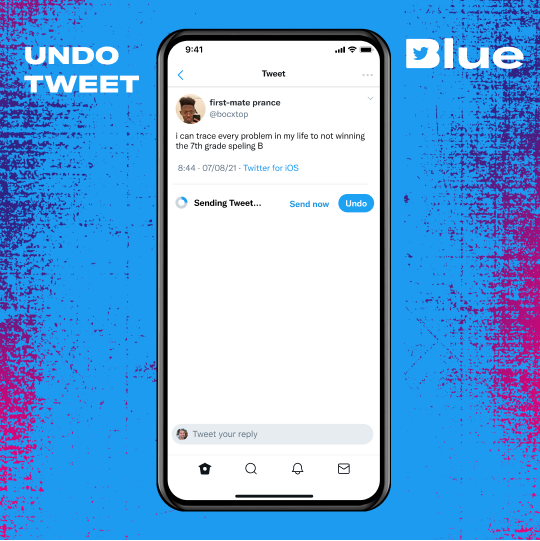The new episode of the podcast Tech News for MBAs is live!
Listen and subscribe to Tech News for MBAs
Apple Podcasts
Spotify
Other links
This is a transcription of Tech News for MBAs, Season 2 / Episode 4. I recommend listening to it, but if you prefer reading, there has been some light editing to make it more legible.
Twitter has released a new paid subscription product called Twitter Blue– the first of its kind.
I know we've talked a bit about web3, which is the new idea of the internet built around crypto. Twitter is one of the OG web2 companies. Web2 is largely built around large scale, free to consumer products that are monetized through advertising.
And so Twitter, traditionally, like its peers (Facebook, Instagram, Pinterest, Snapchat, Google, etc.)– you, the consumer, get to use it for free, and Twitter sells access to that audience, to you, to its advertising partners. And as consumers, we're totally accustomed to this model. It's not dissimilar from media before it, like TV or radio or newspaper.
Meanwhile, as these social media companies became more and more popular and that model became really ingrained, another trend started happening in different sorts of businesses, which is SaaS (software as a service) models where you pay a monthly or annual fee in order to gain access to a piece of software.
And this model really describes everything from something like Netflix to Slack, where you are paying per month to gain access to that software. And you are directly monetizing for that company. Slack makes money because I'm paying them to use it. There is no third party in this triangle. It's just a direct relationship between me and them.
Twitter Blue, the new product from Twitter, which was announced and released just two days ago this week, is the first time that a major social network is attempting to bring that type of business model into the mix.
Interestingly, this is not instead of advertising– so it's not that today you're using Twitter for free and you're seeing ads, and now you subscribe to Twitter Blue and you don't see those ads. No, no, no. What they're attempting to do is to double dip, where they are still serving you ads and getting that revenue from advertisers, but they're offering special, unique features that are only available to subscribers of Twitter Blue that allows them to have both the SaaS model and the advertising model.
So they're not swapping out one source of revenue for another, but instead they are attempting to increase their revenue per user (ARPU).
So what is Twitter Blue? Twitter Blue costs $2.99 per month, and what you get is a variety of features.
Perhaps the most long awaited feature for Twitter users was the ability to edit a tweet after you had posted. Right now, if you have a typo or something in your tweet, you can't edit it. The only choice would be to delete it and then tweet it again. But now what they've introduced is something called undo tweet. And so as you compose a new tweet and you say, great, send this to the Twitterverse, publish– it delays it by a certain number of seconds. 20 seconds is the default value there, and during that 20 second period, you can decide to undo or to go ahead and send it. And so it basically allows you to proofread your own tweet before it posts. So it's not exactly what Twitter users were asking for, but I think it achieves the same goal. It allows you to sort of catch those mistakes on the way out the door.
That alone is a feature that with the Twitter community is so often requested and talked about. And from a technical perspective, it's not a difficult feature for them to have built. But what they did was they waited years and years and years, even though the demand was there, and then they decided to lock it behind this paywall where you can only have that feature if you pay.
Now, that's just one of the benefits of Twitter Blue. You can also read Twitter threads, which is multiple tweets that are sort of strung together, in a new view that essentially makes it look almost more like an article or a blog post. They also are leveraging their acquisition of the startup Scroll– you can see certain news articles that load in like the web view within Twitter without ads. So it hides the ads on the news websites and actually uses part of your Twitter Blue subscription money to pay those news publications, which is kind of interesting. And there are a bunch of other little features as well. You can customize the color or the icon on your home screen. These are sort of frivolous features, but you get this feeling of like, ok, I'm getting a bunch of stuff for this $2.99,
So let's take a quick look at some of Twitter's numbers here. In Q3 of this year, they reported that they had 211 million daily active users (DAU). So these are people that are using the platform each and every day. That was up only 3% quarter over quarter from Q2. That was up only 3% from Q1. That was up only 3% from Q4 of 2020. So you got the idea: user growth is really just crawling along. They don't have a lot of new users coming in. That being said, their revenue is increasing at a faster rate than their user growth, which means they are effectively monetizing each user on average at a faster and faster clip. So even though the new users are sort of just trickling in, they're growing revenue at a steeper curve. And I think the idea here is that if they can't jumpstart user growth, how do they continue to fuel revenue growth?
Of that 200 some odd million daily active users, what percentage of those are going to use Twitter Blue? Let's just throw out a random number and say that 10% are going to use Twitter blue. I think that's probably quite high. Let's say 20 million people are going to subscribe to Twitter Blue in the near future. So 20 million x $3 a month– now that's $60 million a month.
That's $720 million per year in theoretically new Twitter Blue subscription revenue from 10% of an existing base of users. Twitter's annual revenue last year was $3.7 billion. If you take their quarterly revenue from Q3 and extrapolate it forward, that's looking more like $5 billion on an annualized basis.
So we have $720 million over $5 billion– that would be 14% year over year revenue growth. If you average the last four quarters, it's around 42% revenue growth, and that was without Twitter Blue. So all of a sudden now you're going from 42% to 56% year over year revenue growth, and that's without needing to acquire any more new users than there were before.
Are they really going to get 10% conversion? I have no idea. But it changes the game a bit where increasingly it's about mining their existing user base for potential converts. And if they can just chip away at that 200 million and just get a little more, a little more, every quarter, every month, to subscribe to Twitter Blue, to continue to iterate on the product and find new value for different types of users, to sort of unlock new value with those subscription purchases.
Maybe there are different tiers of service– so it's starting at $2.99, but maybe there's a $4.99 plan. Maybe there's a $9.99 plan. To me, it demonstrates a willingness and an adventurousness on the part of Twitter to pursue these new sorts of monetization strategies that are not just about plastering more and more ads in front of their users. They are finding new ways to provide value and to create different sorts of monetization in different ways.
Twitter has been doing a great job with this. They made some other acquisitions like Revue, a newsletter service. You can imagine a paid newsletter, and now Twitter is taking a little percentage of that. They've added tipping, so you can give money to creators that you really love. Maybe they start to take a piece of that.
And so on and so forth, sort of realizing that vertical user growth is not going to be the strategy here– it's really about providing more and more value and extracting more value from different sources. And users that use Twitter and love Twitter might just be willing to pay.
I don't even know if Twitter's going to break out the Blue subscription numbers in their earnings reports, so we might not have a full view into what's happening there. But if we see the revenue growth sort of increasing and there's no other logical explanation, I think we'll start to say, okay, there really was some pent up demand. And that's my guess for this first quarter. There's a bunch of people that are going to sort of jump on the Twitter Blue train initially, and then it's going to really slow down. All that pent up demand will have been met almost immediately. Then the question is how do they convince that second tier third tier of people to eventually convert to Twitter Blue?
If you don't use Twitter, now might be a great time to start! If you're interested in the world of tech, that's sort of where it's all happening for better or worse.
Personally, I happily threw down my $2.99 for my Twitter Blue subscription. And the truth is I don't even need any of these features. I'm just happy to support this company because I really believe they bring me value. And that is another route here– Hey, want this to exist? Pay for it.
And again, as a consumer, that's a model that now I'm quite accustomed to.
Subscribe to Tech News for MBAs
Apple Podcasts
Spotify
Other links
Disclaimer: I hold $TWTR. This content is for informational and entertainment purposes only and is not financial advice.






